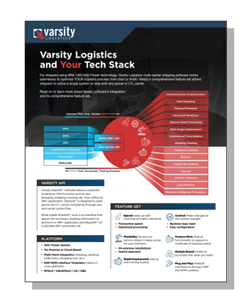
4 Ways Zone Skipping Can Optimize Your Shipping Strategy
Learn how Zone Skipping can lower costs, decrease transit times, and boost customer satisfaction
In a supply chain and logistics environment where economic uncertainty is constant, businesses are always on the lookout for opportunities to reduce transportation costs without sacrificing transit times and customer experience. As e-commerce has continued to thrive by yielding high order volumes, the need for innovative shipping strategies has become more critical than ever.
Many will be relieved to know a logistics approach that offers a solution to both high shipping costs and extended delivery times does indeed exist. This approach is referred to as Zone Skipping, a logistics technique that consolidates individual packages and ships them directly to a parcel carrier’s distribution center closer in proximity to the final destination points of the consolidated packages. From there, a regional carrier delivers the package to the customer’s doorstep.
This technique is called Zone Skipping because consolidating individual shipments and transporting them in bulk to get them closer to their end delivery location allows the packages to bypass intermediate distribution centers, or zones.
How does Zone Skipping work?
Unlike traditional shipping methods that involve multiple sorting and transfer points, Zone Skipping minimizes the extensive routing of parcels across the country before reaching their end destination. Instead, the approach leverages local carriers for the final zone. The main purpose is to consolidate parcels headed for the same target location, allowing them to be shipped together in bulk. This process eliminates unnecessary handling and sorting, resulting in faster transit times and significant cost savings.
4 Ways Zone Skipping Can Benefit Your Business
Now that we’ve laid the foundation for understanding how Zone Skipping works, it is important to explore how this innovative shipping strategy can positively impact your business.
1. Cost Savings
Zone Skipping can bring substantial cost savings for businesses by optimizing the final stages of the shipping journey. Rather than relying solely on individual parcel carriers for end-to-end delivery, Zone Skipping utilizes local delivery services to make final mile deliveries. This strategy eliminates the need for multiple sorting and transfer points along the shipping route, significantly reducing costs associated with shipping packages. This cost efficiency allows businesses to allocate budget elsewhere, bettering the business’s finances and operations.
For example, if you were shipping 5,000 parcels from Oklahoma City to Detroit at $10 each in shipping costs, you would incur a grand total of $50,000 in shipping spend. The flat rate, however, is $5,000 if they all arrive in a truck. From there, shipping the individual parcels from the Detroit sorting facility will cost $7 per parcel. If you add the $5,000 flat rate shipment with the $7 per parcel for local delivery, the total shipping will equal $40,000. That’s $10,000 in savings compared to using the parcel carrier for shipping the parcels individually.
5,000 x $10 = $50,000
(5,000 x $7) + $5,000 = $40,000
$50,000 – $40,000 = $10,000 in Savings!
2. Faster Transit Times
Zone Skipping also revolutionizes the speed and efficiency of parcel deliveries, significantly reducing transit times. Traditional shipping methods involve excessive back-and-forth traveling through multiple sorting facilities across the country throughout the duration of transit. However, this logistics technique utilizes local carriers to minimize unnecessary detours and ensures a direct route to the end customer. Not only does this eliminate transit delays, but it shines a spotlight on businesses offering reliable service. It is no secret that today, especially, faster delivery times translate to higher customer satisfaction.
3. Greater E-commerce Capabilities
As the e-commerce landscape continues to evolve, customer expectations grow right along with it. This means meeting the growing demand for seamless and hassle-free deliveries is crucial for businesses. Zone Skipping presents an ideal strategy for businesses to meet these expectations by providing faster and more reliable shipping options to their customers. With the ability to directly route a package to the customer, avoiding transit delays and sorting, it meets the immediate needs of today’s online shoppers. Not only will this boost your business’s customer service, leading directly to happier customers and increased customer loyalty, but it will help your business excel in the competitive e-commerce market and ultimately drive profits.
4. Fewer Chances for Damaged Packages
Not only does Zone Skipping save your business time and money when it comes to shipping, it also reduces the risk of damaged packages. As we know by now, traditional shipping methods can send packages through multiple sorting and distribution centers, exposing packages to more hands and a higher likelihood of becoming damaged. Zone Skipping decreases the opportunity of something bad happening to packages, such as being dropped or dented, by eliminating unnecessary touchpoints in the shipping process. This helps ensure that customers receive their orders in pristine condition, improving the overall customer experience and building trust with the shipping process and your business.
What Do I Need to Implement Zone Skipping?
Here are 3 things to do before you implement a zone skipping strategy.
Evaluate the Areas You Serve
Before implementing a Zone Skipping strategy, it’s crucial to evaluate the regions you routinely serve. This strategy is most cost-effective for businesses that consistently have a substantial volume of parcels going to the same area. If you are considering utilizing Zone Skipping, you should consider the frequency of orders that are headed to the same region and examine how many steps are in your current shipping process. Remember, reducing the steps in your shipping process creates a more streamlined experience as well as increases cost savings to your business. Ideally, you should have a shipping system that allows you to turn zone skipping on/off based on current volume to ensure optimal efficiency and savings.
Evaluate your Internal Infrastructure
Before jumping into Zone Skipping, evaluate your internal infrastructure to ensure a seamless implementation. You will need software that is equipped to seamlessly handle increased capacity requirements. The integration of a robust solution, like multi-carrier shipping software (MCSS), becomes crucial in this context. Advanced shipping solutions are designed to handle complex shipping scenarios and streamline parcel logistics, ensuring your system remains agile and efficient, even with the increased demands of Zone Skipping. Because of volume, Zone Skipping may overly burden a more traditional system, which could reduce efficiency and increase labor costs. By leveraging the capabilities of multi-carrier shipping software, business will be able to effectively utilize Zone Skipping to deliver ROI and operational efficiency.
Open a Dialogue with your Local Parcel Carriers
It’s important to foster a collaborative partnership with your local parcel carriers as these are the people you’ll rely on to make Zone Skipping a successful strategy. Communication with these carriers is vital to smooth operations and an effective plan. While Zone Skipping might reduce the sorting and shipping workload on your part, transparent communication with your local carriers will help them recognize the substantial benefits of increased volume. A collaborative approach to this strategy ensures benefits for both your business and the carriers involved.
Zone Skipping with Varsity Shipping Software
Zone Skipping is an effective way to reduce shipping costs and improve customer experience. The industry leading multi-carrier shipping software for IBM i (AS/400) Power systems users from Varsity Logistics offers the ideal solution for flexibility and reliability when it comes to additional cost savings and promoting a positive customer experience.
Read our How it Works Brochure to learn more about Varsity’s software integration and comprehensive set of features.

To discover all the ways Varsity’s multi-carrier shipping software can improve your parcel shipping processes, contact our shipping experts or schedule a demo.





